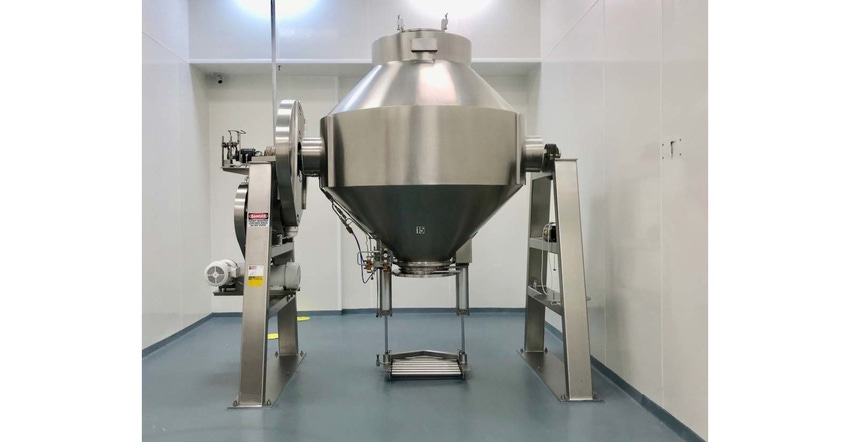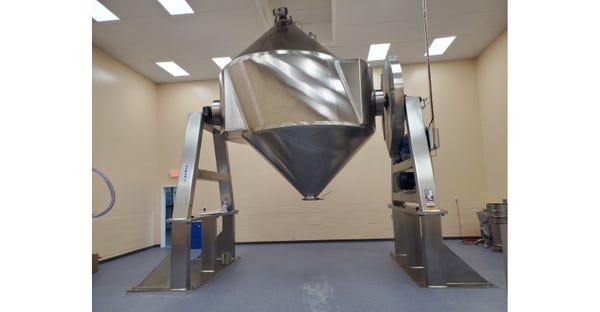Five Key Factors of the Perfect Powder Blending
It is important to understand the properties of the powders being blended, the desired output of the blend, and the expertise of the manufacturer and testing facility.
July 21, 2023

Gregg Muench, director of sales/marketing, GEMCO
Powder blending is the process of mixing two or more powders together to create a homogeneous mixture. This process is essential in many industries, including the pharmaceutical, food, and chemical industries.1 To ensure that the blending process is successful, it is important to understand the properties of the powders being blended, the desired output of the blend, and the expertise of the manufacturer and testing facility.
Here is what you should determine before blending: particle shape, powder density, particle size, static electricity, expertise. This ensures that your powder blending process is successful and that you get the desired results. By considering these factors and properly planning your future blend, you can ensure that the process will be successful and produce the desired results.2
The Key to Homogeneity: Particle Shape
The particles' shape can affect the blend's homogeneity, flowability, and physical properties.3
Homogeneity of the blend: Particles with different shapes tend to segregate. This means that they will tend to clump together. That is the reason why it can be difficult to achieve a homogeneous mixture where the particles are evenly distributed throughout.
For example, consider a mixture of spherical and irregular particles. The spherical particles will tend to roll around and mix more easily, while the irregular particles will tend to stick together. This can lead to segregation, where the spherical particles and the irregular particles form two separate layers.
To prevent segregation, it is important to blend powders with similar shapes. If you must blend powders of different shapes, you can use a technique called size segregation. This involves blending the powders into different sizes. For example, you could blend the spherical particles in the fine range and the irregular particles in the coarse range. This will help distribute the particles more evenly throughout the mixture.
Flowability of the blend: The shape of the particles can affect the flowability of the mixture. For example, spherical particles tend to flow more easily than irregular particles. This is because spherical particles have a larger surface area to volume ratio, which makes them easier to slide past each other.
Irregular particles, on the other hand, have a smaller surface area-to-volume ratio. This means they are more likely to stick together, making it more difficult for them to flow.
To improve the flowability of a powder mixture, it is important to blend powders with similar shapes. If you must blend powders of different shapes, you can use a technique called agglomeration. This involves coating the particles with a binder, which helps to bind them together and make them flow more easily.
Physical properties of the blend: The shape of the particles can also affect the physical properties of the blend. For example, a mixture of spherical particles will be denser than a mixture of irregular particles. This is because spherical particles pack together more tightly than irregular particles.
The density of the powder mixture can affect its flowability, its compressibility, and its strength. [4] For example, a denser powder mixture will be more difficult to flow and compress. However, it will also be stronger.
The Science of Flowability: Powder Density
The density of powders is another important factor to consider when blending powders. The density of powders can affect their flowability, compressibility, and strength.5
Flowability of powders: The density of powders can affect their flowability.6 For example, denser powders are more difficult to flow than less dense powders. This is because denser powders have more mass per unit volume, which makes them more difficult to move.
If you want to improve the flowability of powders, it is important to blend powders with similar densities. If you must blend powders with different densities, you can use a technique called dilution. This involves blending the powders with a carrier powder, which helps reduce the overall density of the mixture.
Compressibility of powders: The density of powders can also affect their compressibility. For example, denser powders are more compressible than less dense powders. This is because denser powders have more space between the particles, which makes them easier to compress.
Blending powders with similar densities is important if you need better compressibility. If you must blend powders with different densities, you can use a technique called compaction. This involves compressing the powders under high pressure, which helps to increase their density and improve their compressibility.
Strength of powders: The density of powders can also affect their strength.7 For example, denser powders are stronger than less dense powders. This is because denser powders have more mass per unit volume, which makes them more difficult to break.
To improve the strength of powders, it is important to blend powders with similar densities. If you must blend powders with different densities, you can use a technique called reinforcement. This involves adding a reinforcing agent to the powders, which helps to increase their density and improve their strength.

The Fine Art of Blending: Particle Size
The particle size distribution of the ingredients used in a powder mixture is one of the key factors that determines the homogeneity of the mixture. Small particles show a tendency to fall downward, leading to segregation, and that is why mixing particles of different sizes can be a challenge.8
Homogeneity of the blend: The particle size distribution of a powder mixture can affect its homogeneity. For example, a mixture with a wide particle size distribution will be more likely to segregate than a mixture with a narrow particle size distribution.
To improve the homogeneity of a powder mixture, it is important to blend powders with a narrow particle size distribution. If you must blend powders with a wide particle size distribution, you can use a technique called size segregation. This involves blending the powders into different sizes. For example, you could blend the small particles in the fine range and the large particles in the coarse range. This will help distribute the particles more evenly throughout the mixture.
Flowability of the blend: The particle size distribution of a powder mixture can also affect its flowability. For example, a mixture with a narrow particle size distribution will be more likely to flow easily than a mixture with a wide particle size distribution.
This is because powders with a narrow particle size distribution are more likely to form cohesive aggregates, which makes them easier to flow. To improve the flowability of a powder mixture, it is important to blend powders with a narrow particle size distribution.
The Dangers of Static Electricity in Powder Mixing
The "triboelectric" phenomenon known as a static charge is brought on by the friction of two materials rubbing against one another. Static buildup in equipment can frequently be seen in blenders, grinders, and screeners. A mixing system may generate a lot of static electricity. An ESD (electrical discharge) can result from static electricity that lacks a grounded path to travel. Uncontrolled ESD events have the potential to short-circuit electronic parts, start fires, or interfere with the flow or discharge of powder during processing.9
Static charges cause:
* Unsafe working conditions
* Segregation at discharge
* Slow or inefficient mixing
* Excessive powder residue left on blender walls.
Environmental variables such as relative humidity influence the level of electrostatic charges. When humidity is low, higher static charges will typically be generated. For this reason, static becomes more noticeable in the winter months, in dry climates, and if air conditioning is used.10
There are several ways to prevent static electricity while mixing powders. These include using anti-static materials, grounding the equipment, or adding moisture. Also, you can prevent static electricity by using the powder blender that is designed to minimize it, and it is necessary to keep the powder blender clean and free of dust.
The Difference Between Good and Great: Expertise
It’s important to choose a proven company when choosing the right blending equipment and to conduct an extensive analysis of your material before blending. By analyzing the materials prior to blending, you can help identify any potential risks, such as the risk of static electricity, fire, or explosion. This will allow you to take steps to mitigate these risks and ensure the safety of your blending operations.
Here are more reasons why:
Expertise: A proven company with experts will have the knowledge and experience to help you choose the right blending equipment for your specific needs. They will be able to consider the properties of your materials, the desired output, and the scale of your operation.
Reliability: They would be able to provide you with reliable blending equipment that will meet your needs and offer warranties and guarantees on their equipment. Also, they will be able to provide you with support if you have any problems.
Safety: Safety is mandatory, and that is why it is important to choose the recommended equipment that is designed to minimize the risk of static electricity, fire, and explosion.
Compliance: A proven company with experts will be able to help you ensure that your blending operations comply with all applicable regulations.
Conclusion
By understanding and implementing the principles of powder blending, you can achieve the desired outcome—the ideal blend. If you don’t know your powder, you can develop problems, which affect choosing the right industrial machinery for the job. By following these principles, you can ensure that your powder blends are homogeneous, flowable, and safe. Here are additional considerations for flawless powder blending:
Planning: Before you start blending, take the time to plan the process carefully. This includes considering the properties of the powders, the desired output, and the safety requirements.
Equipment: The right equipment will help you achieve a homogeneous blend.
Monitoring: It is important to monitor the blending process to ensure that it is proceeding as planned.
Testing: Once the blending process is complete, it is important to test the blend to ensure that it meets the desired specifications.
Gregg Muench is director of sales/marketing, GEMCO (Middlesex, NJ). For more information, call 800-654-3626 or visit www.okgemco.com.
References:
2 https://www.nature.com/articles/s41598-020-77974-3
3 https://www.sciencedirect.com/science/article/abs/pii/S0032591014009334
4 https://www.sciencedirect.com/science/article/abs/pii/S0009250903001374
5 https://www.nature.com/articles/s41598-020-77974-3
6 Significance of Powder Density: Knowing Your Material Before Blending | powderbulksolids.com
8 https://www.sciencedirect.com/science/article/abs/pii/S0032591014009334
You May Also Like


